Berlin Wall
![]()
The title of this article is ambiguous. For other meanings, see Berlin Wall (disambiguation).
The Berlin Wall was a border fortification system of the German Democratic Republic (GDR) during the division of Germany, which lasted for more than 28 years, from August 13, 1961 to November 9, 1989, hermetically sealing off the GDR from West Berlin. It not only separated the connections in the area of Greater Berlin between the eastern part ("capital of the GDR") and the western part of the city, but also completely enclosed all three sectors of the western part, thus also cutting off its connections to the Berlin hinterland, which was located in the GDR district of Potsdam.
The Berlin Wall is to be distinguished from the former inner-German border between West Germany (old Federal Republic) and East Germany (GDR).
The Berlin Wall, as the last action in the division of the four-sector city of Berlin created by the Allies' post-war order, was both a component and a striking symbol of the Cold War conflict between the Western powers dominated by the United States and the so-called Eastern bloc led by the Soviet Union. It was built on the basis of a decision by the political leadership of the Soviet Union at the beginning of August 1961 and a directive from the GDR government issued a few days later. The Berlin Wall supplemented the 1,378-kilometre-long inner-German border between the GDR and the Federal Republic of Germany, which had already been "fortified" more than nine years earlier in order to stop the flow of refugees.
Since 1960, the GDR border guards had been subject to shoot-to-kill orders in cases of "unlawful border crossing", which were not formally passed into law until 1982. According to current research (2009), between 136 and 245 people were killed in attempts to cross the 167.8 kilometres of heavily guarded border fortifications towards West Berlin. The exact number of fatalities at the Berlin Wall is not known.
The Berlin Wall was opened on the evening of 9 November 1989 in the course of the political turnaround. This happened under the growing pressure of the GDR population demanding more freedom. The fall of the Wall paved the way that led to the collapse of the SED dictatorship, the dissolution of the GDR and, at the same time, the state unity of Germany within a year.
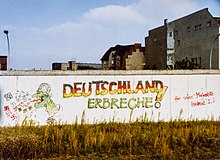
Graffiti directed against Helmut Kohl and reunification in the former death strip Mühlenstraße, 2 October 1990
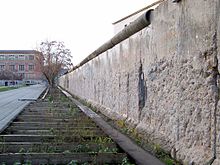
Remains of the Berlin Wall at Niederkirchnerstraße, 2004
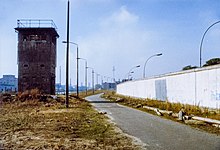
Death strip and watchtower of the type "Führungsstelle" (command post) at Mühlenstraße, 1990 - there the Hinterland wall corresponded to the type "Stützwandelement UL 12.41" (retaining wall element UL 12.41), which otherwise faced the west
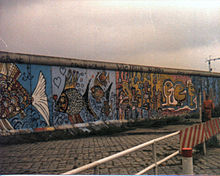
The Berlin Wall from eye level at Potsdamer Platz, 1985
.webm.jpg)
Play media file Animation of the construction of the wall

Map of the Berlin Wall (brown) before 1989, including* western and southern Berlin outer ring* border crossing points 1-14* area exchange A: Staaken - Gatow/Weinmeisterhöhe (1945) * area exchange B: Spandau - Falkensee (after 1970) * area exchange C: Zehlendorf - Babelsberg (after 1970) * sectors: I. = France, II. = Great Britain, III. = USA (including V. Steinstücken), IV.= so-called "Democratic Sector" (East Berlin).
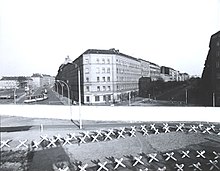
Border strip with Hinterland wall, view from a viewing platform on Bernauer Strasse (west) to Eberswalder Strasse and Oderberger Strasse (east), 1973
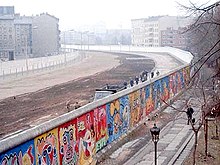
Graffiti on the West Berlin side, on the East Berlin side the leveled grounds of the Luisenstädtischer Kanal, 1986
Linguistic aspects
The term "anti-fascist protective wall" for the Wall first appeared as a "legendary political campaign term" (according to Gunter Holzweißig) in a submission by the Agitation Commission at the Politburo of the SED dated 1 August 1962. It was used in the strategy paper "Proposals for an offensive political campaign against the ultras in West Berlin and West Germany", which was intended to serve the ideological-propagandistic justification of the building of the Wall. The suggestion that the open border with West Berlin represented a "fascist" threat to the GDR was intended to conceal the true motive: the main purpose was to prevent people from fleeing the GDR.
Since the Wall was erected not only between East and West Berlin, but also on the border with the territory of the GDR surrounding West Berlin, the western part of the city, until then the "shop window of the free world", was henceforth a walled-in western island.
In order to avoid conflict-laden terms such as Wall, West and East Berlin, state border, etc., the simple term "sector border" became established in everyday political and public life in West Berlin. Since this term also generally described the boundaries between the British, French, and American sectors, which, however, had little meaning in everyday life, it could also be used neutrally to describe their boundaries to the Soviet sector, i.e. the inner-city Berlin Wall.
History
Previous story
1945–1949
After the end of the Second World War, Germany was divided into four occupation zones in 1945 in accordance with the EAC zone protocols or the agreements of the Yalta Conference, which were to be controlled and administered by the Allied victorious powers USA, USSR, Great Britain and France. Similarly, Greater Berlin, the former capital of the Reich, was divided into four sectors.
In the summer of 1945, demarcation lines were drawn between the occupation zones, the so-called "zone borders". In some cases, turnpikes and white-yellow wooden pillars were erected and coloured markings were made on trees. A permit was now required to cross the zone border; only commuters and farmers were allowed to cross the border. By order of the Soviet Military Administration in Germany (SMAD), a border police force was established in the Soviet Occupation Zone (SBZ), which became active for the first time on December 1, 1946, regulations for the use of firearms were enacted. Interzone passports now had to be applied for to travel between the SBZ and the western zones. The first border fortifications were erected on the eastern side, barbed wire obstacles in particular in forest areas, and roadblocks along cross-border roads and paths.
A little later, the Cold War between the West and the developing Eastern Bloc began on a wide variety of levels. At first, the Cold War conflict was followed by a mutual exchange of blows between the Western Allies and the Soviet Union. The first intractable rift was over reparations, over which a dispute arose between the four Allies, who were still meeting together. Since the USSR saw in the meantime that it could not cover its needs for reparations from its zone, it demanded in 1946/1947 at various Allied conferences a share in the reparations from the Ruhr, otherwise it could not agree to an economic unity planned in the Potsdam Agreement. Only France accepted this, the USA and Great Britain did not.
In addition, there was the problem of the different social systems - capitalism on the one hand and communism on the other, whereby the Soviet Union purposefully planned to build a communist social structure in its sector as well. However, this contradicted the intentions of the Western powers.
The Soviet Union was excluded from the London Six-Power Conference in February 1948, at which the Western powers held their first negotiations on, among other things, a separate state in western Germany; it was not invited. As a result, the Soviet Union withdrew from the supreme Allied authority in Germany, the Control Council, in March, leaving no joint inter-Allied control over Germany. In March 1948, the three victorious Western powers agreed, after France abandoned its opposition, to form a joint trizone out of the three Western zones. About three months later, at short notice - and to the general public's surprise - currency reform was carried out in this new unified zone from 20 June 1948, introducing the D-Mark (West) and devaluing the Reichsmark. At this time, the SPD-dominated Berlin Magistrate was still wavering about the form in which Berlin should participate in the upcoming currency reform.
The result of the currency reform was a division of Germany's political and economic unity into two opposing zones with two different currencies. Greater Berlin was divided into two currency areas because the Western Allies in their sectors had not accepted the introduction of the DM East ordered by the SMAD and had in turn introduced the DM West as a second currency. Among other things, this created initial problems when the place of residence and place of work of Berlin's inhabitants were located in the other area.
The Soviet Union reacted with the Berlin Blockade which lasted from 24 June 1948 to 12 May 1949. During this time, Berlin was divided and the first Berlin crisis occurred.
Another effect of the Cold War was that Greater Berlin became a central area of mutual spying by the intelligence services of East and West.
1949–1959
Immediately after the end of the Soviet blockade, the Federal Republic of Germany was founded in the territory of the trizone on 23 May 1949. On 7 October of the same year, the founding of the German Democratic Republic followed in the SBZ. Formally, Berlin had the status of a demilitarized four-sector city with respect to the German military and was independent of the two German states, but in practice this had little meaning. In many respects, West Berlin approximated the status of a federal state and was also regarded as such by the Federal German side, although later, as part of the policy of détente and the treaties with the East, sessions of the German Bundestag, the Bundesrat and the Federal Assembly were not held in West Berlin. When the GDR was founded, the whole of Berlin was declared its capital. The designation capital of the German Democratic Republic for the eastern part of the city was not introduced until the 1960s. Initially, the eastern part bore the propagandistic name Democratic Sector. Since the existence of the GDR, citizens fled to the Federal Republic, also taking extraordinary and often life-threatening means of escape.
In 1952, the GDR began to secure the German-German border by means of fences, guards and alarms, and also established a five-kilometre-wide exclusion zone that could only be entered with special permission - typically for residents. Towards the border, there was again a 500-meter-wide protective strip, followed immediately by a ten-meter-wide control strip. "Unreliable" residents were forcibly relocated from the border area - for example in the "Aktion Ungeziefer".
The SED leadership had also been considering sealing off the border to the western sectors since 1952. On the one hand, however, the Soviet Union did not give its consent, and on the other hand, sealing off the border would hardly have been possible for traffic reasons: It is true that as early as 1956, the SED leadership had the Potsdam Pirschheide railway station - currently largely in ruins - expanded into the Potsdam-Süd railway station, which was renamed "Hauptbahnhof" in 1960. However, the Deutsche Reichsbahn continued to rely on journeys through the western sectors. Bypassing West Berlin was only possible with the full completion of the Berliner Außenring (BAR) in May 1961, a railway ring that simultaneously secured connections to the radial lines crossing it to the stations of Birkenwerder, Hennigsdorf, Albrechtshof, Staaken, Potsdam Stadt, Teltow, Mahlow, and ultimately the connection to the Görlitzer Bahn. The only transport project that at that time allowed for truly independent transport without using the territory of the western sectors was the Havel Canal, which was built with considerable achievement from 1950 to 1952.
Nevertheless, the People's Police carried out intensive checks on people on many roads leading into the western sectors, on railways and other means of transport, in order to apprehend suspected fugitives and smugglers, among other things. However, the 45.1-kilometer-long sector border as the city border between West and East Berlin and the border to the surrounding area of about 120 kilometers could hardly be completely controlled, so they acted as a loophole through the border, which initially remained open.
Thus, from 1945 until the construction of the Berlin Wall, a total of about 3.5 million people fled, including about 2.6 million people from the Soviet occupation zone and the later GDR as well as East Berlin between 1949 and 1961. In addition, for many people from Poland and Czechoslovakia, Berlin was also a gateway to escape to the West. Since the refugees were often well-educated young people, this exodus threatened the economic strength of the GDR and ultimately the existence of the state.
1959–1961
The Soviet Union pursued the goal of transforming West Berlin into a Free City, achieving recognition of the GDR by the Federal Republic and a peace treaty. In the event of rejection, it threatened the Western powers with giving the GDR control of all routes between the Federal Republic and the western sectors of Berlin. The German government rejected the demands, which were part of Khrushchev's ultimatum, on January 5, 1959. The United States likewise refused to give up its position in Berlin. This led to the failure of these longer-term attempts by the Soviet Union.
During these three years (1959-1961), moreover, the situation came to a head again, and the GDR fell into a renewed crisis in almost all areas, but even deeper than in 1952/1953. During the first crisis in the GDR from 1952 to 1953, the USSR still stepped in and waived some of the payments, for example, when the Soviet joint stock companies were handed over to the GDR, and made additional deliveries of grain, ore and coke. After the popular uprising, there was another waiver of payments and there were again deliveries of goods. However, in the present crisis, caused among other things by mistakes in the collectivization of agriculture, there was no support from the Soviet Union for the GDR in the form of additional supplies or payments. The information on the crisis is itself documented, among other things, by reports from the MfS to the party and state leadership.
Another problem was the "East and West border crossers" in the Berlin area. At the time of the introduction of the Ost-Mark in Berlin and the SBZ on 23 June 1948 and the Deutsche Mark (DM-West) in the western sectors of Berlin on 24 June, some 122,000 West Berliners were employed in East Berlin or in the Berlin environs, where they were paid in Ost-Mark (Ost-Grenzgänger), while 76,000 East Berliners worked in the western sectors of Berlin, where they were paid in DM-East and gradually increased rates in DM-West (West-Grenzgänger). In order to maintain the free choice of occupation in the Berlin labor market, the Western powers had created a wage compensation fund in March 1949, when the gradual introduction of DM-West in their sectors was completed. There, East Berliners could exchange 60% of their DM-East wages for DM-West at a rate of 1:1, while West Berliners were paid only 10% of their income in DM-West and 90% in DM-East. Because after the division of Berlin the East border crossers could not be integrated into the political and socio-political program of the SED, the building of socialism, it reduced their number by mass dismissals and the closing of the border of Berlin to the GDR for West Berliners from the year 1952 to 13,000. Almost half of the East border crossers were employees of the German Reichsbahn in 1961, the rest were performing artists, musicians, highly qualified scientists and technicians or they belonged to the staff of the two Christian churches. With the reduction in the number of eastern frontier workers, the SED had made it possible for the Lohnausgleichskasse to raise the western pay rate for western frontier workers to 40%, or a maximum of DM 275-west, by 1961. Despite administrative disadvantages at their place of residence, their number amounted to about 50,000 in the spring of 1961. In contrast to their fellow citizens, they could afford holiday trips to West Germany or other Western countries as well as the purchase of high-quality "Western goods". The existence of these citizens, who could not be integrated into the construction of socialism, was a constant source of annoyance to the SED. In preparation for the building of the Wall, it launched a smear campaign against the Western border crossers as traitors, criminals, and parasites. To solve the problem, the East Magistrate suggested to the Senate that a joint commission be formed; however, Governing Mayor Willy Brandt rejected talks: "There would be no border-crosser problem if the other side paid attention to free choice of occupation." As a result, on August 4, 1961, the East Berlin Magistrate ordered that West border crossers would henceforth have to pay rents as well as other taxes in DM-West, which in practice would have meant the end of them.
Moreover, in these last years before the Wall was built, the number of refugees to the West - including well-educated professionals - increased rapidly, which greatly exacerbated the GDR's economic crisis. Half of the refugees were under 25 years old. The shortage of labor was now so severe that the GDR was in danger of being unable to sustain its economy, with a shortage of 45,000 workers in the eastern part of Berlin alone. The GDR was threatened with both a personnel and intellectual bloodletting. This wave of flight also reached record levels in 1961. In the month of July there were already 30,000 and on 12 August 1961, i.e. on a single day, 3,190 people fled.
Wall Construction
The decision to close the sector border was taken at a meeting between Khrushchev and Ulbricht in Moscow on 3 August 1961, after the Soviet leadership had long opposed such a project since the mid-1950s. The plan to build the Wall, or literally, to secure the western border, was then decided at the meeting of the political leaders of the Warsaw Treaty states from 3 to 5 August 1961. The Wall was intended to serve the rulers of the Eastern Bloc to finally stop the colloquially referred to "voting with their feet", away from the "socialist workers' and peasants' state", by sealing off the borders.
The plan to build the Wall was a state secret of the GDR government. It was not until August 10, 1961, three days before the Wall was built, that the Federal Intelligence Service received the first indications that the Wall was being built. The Wall was built by construction workers at the behest of the SED leadership under the protection and surveillance of People's Police officers and soldiers of the National People's Army - contrary to the assurances of the GDR's Council of State Chairman Walter Ulbricht at an international press conference on June 15, 1961 in the large ballroom of the House of Ministries in East Berlin. The journalist Annamarie Doherr from the Frankfurter Rundschau had asked the question there at the time:
"I would like to ask a supplementary question. Doherr, Frankfurter Rundschau: Mr. Chairman, in your opinion, does the formation of a free city mean that the State border will be established at the Brandenburg Gate? And are you determined to take this fact into account with all its consequences?"
Walter Ulbricht replied:
"I understand your question to mean that there are people in West Germany who would like us to mobilize the construction workers of the capital of the GDR to erect a wall, yes? I am not aware that [there is] any such intention, since the construction workers in the capital are mainly engaged in housing construction and their labor is fully utilized for this, fully employed. No one has any intention of building a wall. We are in favor of contractual regulation of relations between West Berlin and the Government of the German Democratic Republic. This is the simplest and most normal way to settle these questions.
The state border, as is well known, runs, for example, along the Elbe, etc. And the territory of West Berlin belongs to the territory of the German Democratic Republic. In a certain sense, of course, there are state border issues also between West Berlin and the German Democratic Republic, when the neutralization of West Berlin takes place. But there is a difference between the regulations which apply to the state border with West Germany and the regulations which are made for Berlin."
- Dokumente zur Deutschlandpolitik IV/6 (1961), 925 ff.
Ulbricht was thus the first to publicly use the term "Wall" in this context - two months before it was even built. However, the construction of the Wall had not yet been decided at that time.
The mentioned goal of a contractual agreement had been confirmed by Ulbricht with Khrushchev in an exchange of letters on 18 and 30 January 1961.
In February, Moscow and East Berlin assumed a peace treaty, which Khrushchev had announced he would conclude with the GDR at his summit meeting with Kennedy in Vienna a week and a half before the Wall was built in June 1961.
The Warsaw Treaty States did not formally adopt the measures of 13 August 1961 until 3 to 5 August 1961 in Moscow; agreements and material preparations had already taken place before then.
Although the Western Allies were informed by sources about the planning of "drastic measures" to seal off West Berlin, they were publicly surprised by the actual timing and extent of the cordon. Since their rights of access to and within Berlin were not curtailed, however, there was no reason to intervene militarily. The foreign ministers of the three Western powers and the Federal Republic decided in Paris on 7 August to take preparatory measures to deal with a critical situation in Berlin.
The Federal Intelligence Service (BND) had also received similar information as early as mid-July. After Ulbricht's visit to Khrushchev during the high-level meeting of the Warsaw Pact states in Moscow from 3 to 5 August 1961, the BND weekly report of 9 August stated:
"Present reports show that the Pankow regime is endeavoring to obtain Moscow's consent for the enactment of thoroughly effective blocking measures - which would include in particular a sealing off of the Berlin sector border and the interruption of S-Bahn and U-Bahn traffic in Berlin. [...] It remains to be seen whether and how far Ulbricht [...] was able to get through in Moscow [...] with corresponding demands."
The published statement of the participating States of the Warsaw Pact meeting proposed "to give way at the West Berlin border to rioting activity against the countries of the socialist camp and to ensure reliable guarding and effective control around the territory of West Berlin." On August 7, in a radio speech, Premier Khrushchev announced a reinforcement of the armed forces on the Soviet western border and the calling up of reservists. On August 11, the East German People's Chamber approved the results of the Moscow consultation and passed a "resolution on peace treaty issues." In it, the Council of Ministers was instructed, in a vaguely worded formulation, to "prepare and implement all measures which prove necessary on the basis of the determinations of the participating States of the Warsaw Treaty and this resolution".
On Saturday, August 12, the BND received the following information from East Berlin:
"On August 11, 1961, a conference of party secretaries of party-affiliated publishing houses and other party functionaries took place at the Central Committee of the SED (ZK). Here it was declared, among other things: [...] The situation of the constantly increasing stream of refugees made it necessary to carry out the sealing off of the eastern sector of Berlin and the SBZ in the next few days - an exact day was not given - and not, as actually planned, in 14 days."
Ulbricht invited members of the SED Politburo, ministers and state secretaries, the chairmen of the bloc parties and the mayor of East Berlin to a "get-together" at 4 p.m. on August 12 in the GDR government's guest house at Großer Döllnsee, some 80 km north of Berlin, where they were cut off from the outside world and under control. He initially concealed the purpose of the meeting; only the members of the SED Politburo had already been admitted on August 7. At about 10 p.m. Ulbricht invited people to a "small meeting". At it he informed his guests: "Based on the Volkskammer resolutions, reliable security measures will be taken at the border tonight."
The resolution, signed by the members of the Council of Ministers without objection, stated: "In order to prevent the hostile activity of the revanchist and militarist forces of West Germany and West Berlin, such control shall be introduced at the borders of the German Democratic Republic, including the border with the western sectors of Greater Berlin, as is customary at the borders of every sovereign state. Reliable guarding and effective control are to be provided at the West Berlin borders in order to cut off the path of rummaging activity." Ulbricht had signed the instructions for the border closure before the guests arrived. Honecker had drawn up "Operation Rose" and was long on his way to East Berlin police headquarters, the operations center for sealing the border with West Berlin.
In the night from August 12 to 13, 1961, the NVA and 5,000 members of the German Border Police (forerunner of the border troops) began to seal off the roads and railways leading to West Berlin, together with 5,000 members of the Schutzpolizei (protective police) and the Volkspolizei-Bereitschaften (people's police) as well as 4,500 members of the Betriebskampfgruppen (company fighting groups). The NVA deployed the 1st Motorized Rifle Division and the 8th Motorized Rifle Division as a second "security squadron" at a depth of about 1,000 meters behind the border, with significant participation of units from Prora. Soviet troops also remained in heightened combat readiness and were present at the Allied border crossings. All remaining transport links between the two parts of Berlin were cut off. However, this only affected the U-Bahn and the S-Bahn. The West Berlin S-Bahn and U-Bahn lines on the tunnel routes under East Berlin territory were only affected insofar as the stations were closed off and it was no longer possible to get on or off the trains. From 13 August onwards, trains ran without stopping in the evening through the stations that had become so-called "ghost stations". Only the lines that touched Friedrichstraße station stopped here to enable them to reach the border crossing point that had been set up. As the then Central Committee Secretary for Security Affairs, Erich Honecker was politically responsible for the entire planning and implementation of the Wall's construction on behalf of the SED leadership.
August 13, 1961 is known as the "Day the Wall was built," but actually only the sector border was sealed off on that day. To secure the border, walls were erected in some places on this and the following days, while fences were erected and barbed wire was drawn in others. On the south side of Bernauer Strasse on the border between the Mitte and Wedding districts, the sidewalk belonged to West Berlin, while the buildings were on East Berlin territory. In such cases, the entrances to the buildings were bricked up. The residents could only get to their apartments through the backyards. In the days after the sector border was sealed off, there were many escape attempts, which were later made more difficult by, for example, the bricking up of windows that opened onto West Berlin at the sector border and the further expansion of the border security installations.
The closure also brought with it bizarre situations, especially in the area of the exclaves, where years later there were also some exchanges of territory. For example, the Lenné Triangle at Potsdamer Platz, although belonging to East Berlin, was left out when the Wall was erected. Due to a lack of authority on the part of the West Berlin authorities, the terrain temporarily developed into a de facto lawless area.
The Soviet government declared on 24 August that the air corridors to West Berlin were being misused to smuggle in West German "agents, revanchists and militarists". West Berlin did not belong to the Federal Republic; therefore, the competence of official agencies of the Federal Republic could not extend to Berlin.
By September 1961, 85 of the security forces alone had deserted to West Berlin, and there were 216 successful escape attempts by 400 people. Unforgotten are the well-known pictures of refugees who abseiled from houses on Bernauer Strasse on bed sheets, an old woman who let herself fall into a jump sheet of the West Berlin fire brigade, and the young border police officer Conrad Schumann who jumped over the barbed wire.
West German and West Berlin Reactions
On the same day, Chancellor Konrad Adenauer appealed to the population over the radio for calm and prudence and referred to unspecified reactions that would follow together with the Allies. He did not visit West Berlin until August 22, nine days after the Wall was built. On the political level, only the governing mayor Willy Brandt protested vigorously - but ultimately powerlessly - against the walling-in of West Berlin and the seemingly final division of the city. In the same year, the West German states founded the Central Registration Office of the State Justice Administrations in Salzgitter to document human rights violations on the territory of the GDR and thus, at least symbolically, put a stop to the regime. On August 16, 1961, Willy Brandt and 300,000 West Berliners staged a protest demonstration in front of Schöneberg City Hall.
In the official language of the Senate, the wall was soon referred to only as the Wall of Shame.
Allied reactions
The reactions of the Western powers to the building of the Wall came hesitantly and successively: after 20 hours, military patrols appeared at the border. After 40 hours, a legal notice was sent to the Soviet commander of Berlin. After 72 hours, diplomatic protests from the Allies - to conform to form - were received directly in Moscow. Rumors persisted that the Soviets had previously assured the Western Allies that they would not touch their rights to West Berlin. In 1970, Egon Bahr received word that none of the Western powers had protested in Moscow against the construction of the Wall.
Based on this attitude of the Soviets, the American President Kennedy had already given his agreement to the Soviet Prime Minister Khrushchev at a meeting in Vienna at the beginning of June 1961 that measures could be taken to prevent the migration of people from the GDR and East Berlin to West Berlin. The precondition, however, was free access to West Berlin. In fact, given the experience of the Berlin Blockade, the status of West Berlin was always at risk in the eyes of the Western Allies - the building of the Wall was now a concrete manifestation of the status quo:
"A wall is a hell of a lot better than a war"
- John F. Kennedy, US President
"The East Germans are stemming the flow of refugees and entrenching themselves behind an even tighter Iron Curtain. There's nothing inherently illegal about that."
- Harold Macmillan, British Prime Minister
US President John F. Kennedy's initial reaction was reserved, but he stood by the "free city" of Berlin. He reactivated General Lucius D. Clay, the "father of the Berlin Airlift", and sent him to West Berlin together with US Vice President Lyndon B. Johnson. The two arrived in the city on August 19, 1961. The American combat forces in the city were reinforced: 1,500 men of the 8th U.S. Infantry Division, coming from Mannheim, drove over the transit route through East Germany to West Berlin. On their arrival in the city, the troops were greeted by the people with such great jubilation that the US mission wrote to Washington that they were reminded of the enthusiasm at the liberation of France in the Second World War. Both made it clear to the bewildered West Berlin population that the United States would stand by its rights in the city. The Americans vigorously rejected attempts by the People's and Border Police to control Allied officers and employees. Finally, Marshal Ivan Konev, commander-in-chief of the Soviet Armed Forces Group in Germany (GSSD), had a moderating effect on GDR officials.
A direct confrontation between American and Soviet troops took place on October 27, 1961, at Checkpoint Charlie on Friedrichstraße, when - as a result of disagreements - 30 battle tanks each of the American and Soviet armies drove up directly opposite each other on the border strip. The next day, however, both groups of tanks were withdrawn. This "cold skirmish" had enormous political significance, however, because in this way the Americans had succeeded in proving that the USSR and not the GDR was responsible for the eastern part of Berlin. Both sides did not want to escalate the Cold War over Berlin or even risk a nuclear war.
In a television interview on February 28, 1962, U.S. Secretary of State Dean Rusk spoke in favor of the creation of an international authority to monitor free access to Berlin and against recognition of the GDR, and on April 24 Rusk stated that the U.S. government considered free access to Berlin incompatible with powers of GDR authorities over access routes. In turn, West German Foreign Minister Heinrich von Brentano and French President Charles de Gaulle spoke out in press conferences against an international access control authority for Berlin.
In June 1963, US President John F. Kennedy visited Berlin. In front of Schöneberg City Hall, he gave a speech about the Wall in which he uttered the historic words "Ich bin ein Berliner" (I am a Berliner). This symbolic act meant a lot to West Berliners - especially considering American acceptance of the Wall's construction. For the Western Allies and the GDR, the construction of the Wall meant political and military stabilization, the status quo of West Berlin was fixed - the Soviet Union gave up its demand for a demilitarized, "free" city of West Berlin, formulated in Khrushchev's ultimatum as late as 1958.
On 22 August 1962, the Soviet command in Berlin was dissolved. On September 28, 1962, U.S. Secretary of Defense Robert McNamara declared in Washington that free access to Berlin must be secured by all means. The foreign ministers of the three Western powers and the Federal Republic agreed in Paris on 12 December 1962 that no new proposals should be made to the Soviet Union on the Berlin question.
On the occasion of a working visit by German Chancellor Ludwig Erhard to Paris on 11 June 1964, French President Charles de Gaulle offered the immediate use of French nuclear weapons in the event of a military conflict over Berlin or the Federal Republic.
In a joint declaration on June 26, 1964, on the Treaty of Friendship between the Soviet Union and the GDR of June 12, 1964, the governments of the three Western powers reaffirmed their joint responsibility for the whole of Berlin.
GDR propaganda
GDR propaganda portrayed the Wall, as well as the entire border security with the Federal Republic, as protection against "migration, infiltration, espionage, sabotage, smuggling, sellouts, and aggression from the West. Part of the propagation of this image was the organization of show trials, of which the one against Gottfried Strympe ended with a judicial murder in 1962. The barriers were mainly directed against the country's own citizens. This fact was not allowed to be discussed in public in the GDR, nor was the fact of the mass escape from the GDR. Initially, leaving the territory of the GDR without permission had been a punishable offence since 1954, in accordance with § 8 of the GDR's passport law. It was not until the GDR's penal code came into force on 1 July 1968 that unlawful border crossing was punishable with a prison sentence of two years, although in sentencing practice this was exceeded by up to five years. An amendment to the law on 28 June 1979 set the maximum sentence at eight years.
In 1966, on the occasion of the fifth anniversary of the erection of the Wall, Ulbricht demanded that the West German government provide a DM 30 billion loan to the GDR to make up for "at least part of the damage" it had suffered from "plundering" by the West before the Wall was erected. The Bonn government had intended "to begin an open attack on the GDR, civil war and military provocations after the elections (in September 1961)". The building of the Wall had saved the peace of the world.
Divided country
The construction of the Wall soon turned Berlin from the easiest place for an unauthorized crossing from East to West Germany into the most difficult. West Berliners had already not been allowed to enter the GDR freely since June 1, 1952, and after the Wall was erected they could no longer visit East Berlin from August 26, 1961. After long negotiations, the Passierschein Agreement was reached in 1963, allowing several hundred thousand West Berliners to reunite with their relatives in the eastern part of the city at the end of the year. In 1964, 1965, and 1966, temporary passes were again issued. A fifth pass did not follow. From 1966 onwards, the GDR issued passes to West Berliners for visiting relatives in the eastern sector only in "hardship cases".
From 13 April 1968, the GDR banned ministers and officials of the Federal Republic from transit to West Berlin through its territory. On 19 April 1968, the three Western powers protested against this order. On 12 June 1968, the GDR introduced passport and visa requirements for transit traffic between West Berlin and the Federal Republic of Germany. In response to the visa fees introduced by the GDR for Berlin traffic, the NATO Council decided to charge a fee in future for travel permits for GDR officials to NATO countries. On 8 February 1969, the GDR government issued a transit ban, effective 15 February, for members of the Federal Assembly summoned to West Berlin, as well as for members of the Bundeswehr and members of the Defense Committee of the German Bundestag. The Soviet government protested against the election of the Federal President in West Berlin. Nevertheless, Gustav Heinemann was elected Federal President on 5 March 1969.
On December 15, 1969, the three Western powers proposed to the Soviet Union four-power talks on improving the situation in Berlin and on the access routes to Berlin. In 1971, the Four-Power Agreement on Berlin secured the accessibility of West Berlin and ended the economic threat by closing the access routes. Furthermore, all four powers reaffirmed their joint responsibility for the whole of Berlin and made it clear that West Berlin was not part of the Federal Republic and should not be governed by it. However, while the Soviet Union referred to the four-power status only in terms of West Berlin, the Western Allies underlined their view of the four-power status over all of Berlin in a note to the United Nations in 1975.
From the early 1970s, the policy of rapprochement between the GDR and the Federal Republic of Germany initiated by Willy Brandt and Erich Honecker (→ New Ostpolitik) made the border between the two states somewhat more permeable. The GDR now granted travel facilities, primarily for "unproductive" population groups such as pensioners, and made it easier for German citizens from regions near the border to visit the GDR. The GDR made more comprehensive freedom of travel dependent on recognition of its status as a sovereign state and demanded the extradition of GDR travellers who were unwilling to return. On the basis of the Basic Law, the Federal Republic did not comply with these demands.
Between 13 August 1961 and 9 November 1989 there were 5075 successful escapes to West Berlin, 574 of them desertions.
· 
Divided street. The properties of Bouchéstraße belonged on the left to the East Berlin borough of Treptow, on the right to the West Berlin borough of Neukölln, 1989.
· 
Expanded metal lattice fence in the border area of Berlin
· 
Sector border in Heiligensee, 1982
· 
Wall complex in Berlin-Steinstücken from the air, 1989
· 
Railway line interrupted by the border near Heiligensee, 1987
· 
Police-guarded lock to the so-called "Kubat-Dreieck" (Lenné-Triangle) at Potsdamer Platz shortly before the eviction in 1988
· 
Transit train from Hamburg passes through the border fortifications at Staaken station, 1986
· 
Border crossing Dreilinden for cargo ships at the Teltowkanal near Albrechts Teerofen, 1988
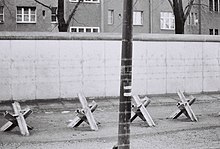
Berlin Wall, Bouchéstrasse, view from the eastern part to West Berlin from a GDR officer's apartment, ca. 1984
_1971,_MiNr_1691.jpg)
10th anniversary of the Berlin Wall. GDR stamp from 1971
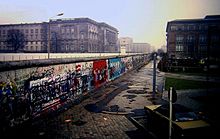
Niederkirchnerstraße wall section between Kreuzberg and Mitte, 1988

"End of British Sector" in front of the Brandenburg Gate, 1988

US President John F. Kennedy and German Chancellor Konrad Adenauer at Checkpoint Charlie on June 26, 1963
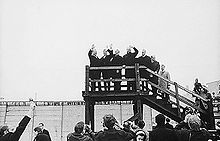
US President Richard Nixon at the Berlin Wall, 1969
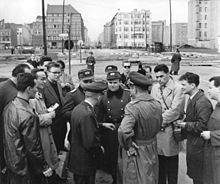
US soldiers and GDR people's policemen, October 1961
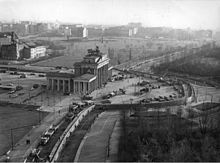
Aerial view of the Brandenburg Gate, 1961
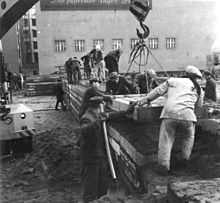
Building the Wall, August 1961
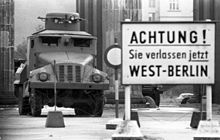
Armoured water cannon G5 SK-2 (Special Power Vehicle 2) at the Brandenburg Gate in August 1961

A Volkspolizist and a Kampfgruppen member secure the construction of the Wall, August 1961
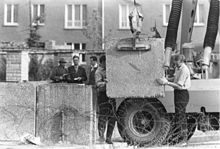
Construction of the wall, erection of concrete blocks, 1961
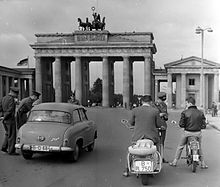
Border control at the Brandenburg Gate (East Berlin side, August 1961)

Station Potsdam Pirschheide in 2009 with designation "Hbf
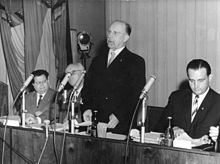
Walter Ulbricht during the press conference on 15 June 1961
Questions and Answers
Q: What was the Berlin Wall?
A: The Berlin Wall was a wall that separated the city of Berlin in Germany from 1961 to 1989, separating the eastern half from the western half.
Q: What did people believe the Berlin Wall was a symbol of?
A: Many people believed the Berlin Wall was a symbol of the Cold War.
Q: When was the Berlin Wall taken down?
A: The Berlin Wall was taken down on November 9, 1989.
Q: How long was the Berlin Wall?
A: The Berlin Wall was about 168 kilometres (104 miles) long.
Q: Why was the Berlin Wall built?
A: The Berlin Wall was built to prevent people from escaping from the eastern half of Berlin.
Q: When was the Berlin Wall built?
A: The Berlin Wall was built in 1961.
Q: How did the removal of the Berlin Wall affect Germany?
A: The removal of the Berlin Wall brought about the reunification of Germany, which had been divided by the wall.
Search within the encyclopedia